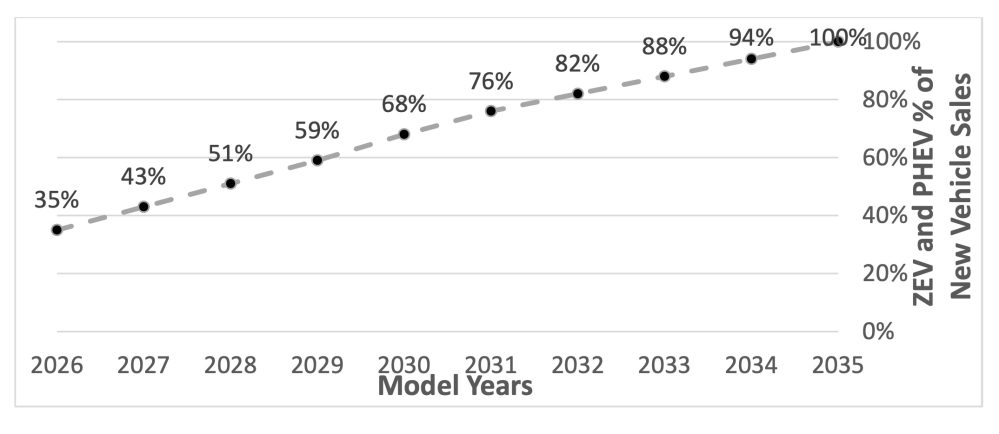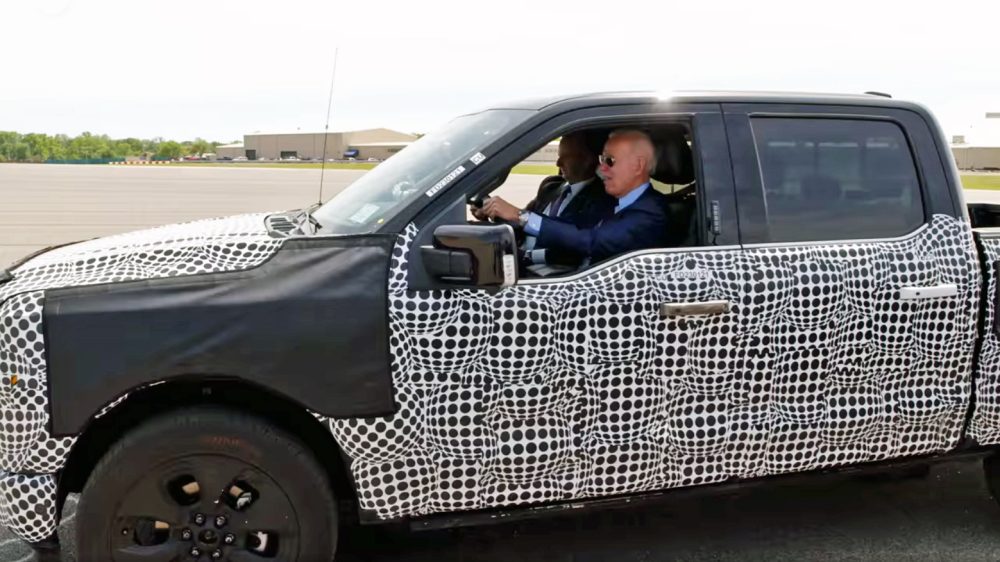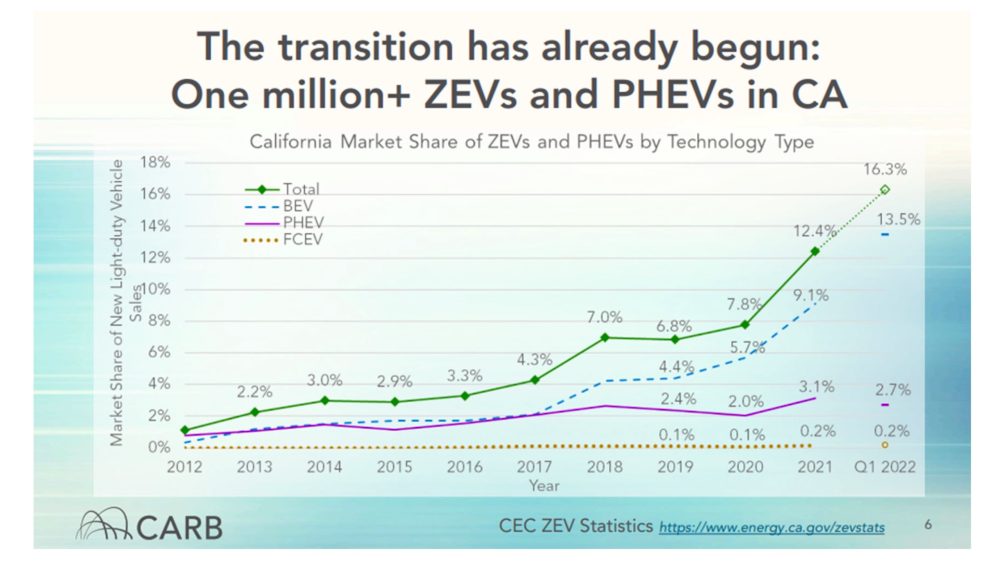
The California Air Resources Board voted unanimously today to implement perhaps its most significant regulation ever – the Advanced Clean Cars II regulation, which officially implements a planned ban on new gas car sales beginning in 2035 and could shake up the entire US auto market.
The ban was first ordered in 2020 by Governor Gavin Newsom, who directed state agencies to draw up a plan. After two years and much work and public comment, the California Air Resources Board (CARB) has now adopted the plan, which California calls the “first-in-the-world” of its kind.
While other governments around the world have set targets for EV adoption and targeted all-EV sales in the 2030-2040 range (with some before 2030), none are nearly as comprehensive as California’s new rules. The regulations could serve as a model not just in the US, but for world governments to look at when considering similar measures.
What California’s 2035 gas car ban does
The specifics of the Advanced Clean Cars II (ACC2) regulation include not just a ban on the sale of new gas-powered light duty passenger cars, trucks and SUVs after 2035, but many other incentives and targets to ensure minimum standards and encourage both new and used electric vehicle sales. These include warranty, durability, serviceability, streamlined charging, and battery labeling requirements.
Here are some of the specifics:
- EVs must come with a charging cord.
- Adapters must be available for standardized public chargers (e.g., Tesla’s upcoming CCS adapter).
- Used vehicles must have battery health metrics so buyers know what they’re getting.
- Batteries must hold 70% of range for 10 years/150K miles (80% after 2030 model year)
- Warranties must guarantee 70% of battery capacity for 8 years/100K miles (75% in 2031 model year).
- EV repair information must be disclosed to independent repair shops.
But despite all of this, there will be some cars allowed with gas engines in them, in the form of plug-in hybrid vehicles. Up to 20% of a manufacturer’s vehicles can be PHEVs, so potentially, up to 20% of cars in 2035 could still use gasoline.
However, those PHEVs will be regulated to certain minimum standards, such as a 50-mile all-electric range – which few PHEVs on the road today currently get. EVs will also have a minimum battery size of 150 miles.
The regulation phases in gradually over the next decade. Starting in 2026, 35% of new cars must be all-electric, rising in a near-linear fashion to 100% in 2035.

In the time between 2026 and 2035, combustion-engine vehicles will also be more stringently regulated by California’s low-emission vehicle (LEV) rules.
The specifics of the accounting for these metrics lie in a redesigned credit system, which CARB are now calling “values.” If automakers fail to comply with the minimum number of “values” for any given year, a penalty of up to $20K per vehicle can be assessed.
There are also environmental justice components to the regulation, adding targeted help to communities that are most affected by pollution. These include financial incentives that can greatly reduce the price of EVs for low-income buyers (above and beyond the federal EV incentive).
In total, CARB expects that the ACC2 regulation will cut auto emissions by 50% from 2026-2040 when compared to the baseline case, the equivalent of almost a billion barrels of petroleum going un-burned. It will result in far fewer smog-forming emissions and avoid $13 billion in health costs in the state, including avoiding thousands of cardiopulmonary deaths, hospital admissions, and emergency room visits.
Why it’s a huge deal – not just for California
It’s not a surprise to see a big move like this coming out of California. The state dominates US EV registrations – last year, 38% of the country’s EV sales were in California, which bought about six times as many EVs as the next-highest state (Florida).
But this regulation isn’t just relevant to California – it will affect other states, and could serve as an example for the world.
The direct mechanism through which CARB’s measures affect other states is through “Section 177.” Section 177 of the Clean Air Act allows California to set its own emission standards stronger than the federal government, and further allows other states to adopt those same standards.
Currently there are 15 “CARB states” that have adopted CA’s Zero Emission Vehicle (ZEV) program, and two more that accept California’s Low Emission Vehicle (LEV) regulations. Together, those 15 states plus California make up around 40% of the US car market.

Each state will have to go through their own process to adopt these new ACC2 regulations, but it is likely they will do so (NY and MA have already adopted laws with similar intent, and WA did as well with a further 2030 “stretch goal”).
We spoke with Elaine O’Grady, policy director for NESCAUM, an organization that coordinates air quality efforts for Northeast states. Seven of the eight states covered by NESCAUM are CARB states, and O’Grady was confident that these states would adopt California’s regulations.
So if automakers want to sell cars in the US, they’ll have to prepare for California’s rules, which will reach far beyond the borders of California. And since California’s rules are stronger and it’s easier to address one set of regulations than multiple, it’s often easier for automakers to just make cars for the strongest relevant set of regulations and sell them everywhere.
California’s gas car ban may inspire federal action
This is why the emissions fight between California and the EPA was important. Originally, California set strong standards, and then those standards were harmonized with federal standards for the first time under Obama’s fuel efficiency plan in 2012.
Later, in 2018, the now-disgraced EPA administrator Scott Pruitt reversed those national standards after much automaker lobbying. This threatened to bring back a “split market” between CARB states and the rest of the country (which the automakers regretted). Eventually after much legal action, California prevailed (which we predicted – though Toyota seems to have only got the memo yesterday).
California’s victory over the federal government showed how important CARB can be in terms of auto regulations. And the fact that CARB’s regulations were largely adopted by the federal government under Obama – when current President Biden was vice president – shows us a prelude of what might happen in the coming months and years.

Next year, the EPA is expected to adopt new car regulations. It stands to reason that its decision-making might be influenced by the fact that 40% of the US auto market has already committed to electric vehicles. While the US government has not yet thrown its support behind California’s 2035 gas car ban, it did just pass the Inflation Reduction Act, which focused heavily on EV incentives and reformed the EV tax credit. And Biden has signed an executive order targeting 50% EV sales by 2030, not too far behind California’s 68%-by-2030 plan.
So given the Biden administration’s focus on EVs and past EPA actions, we could see some parts of this regulation making their way into the federal register.
Electrek’s Take: But why not sooner?
In our original post on this, we asked: Why not sooner?
And we do stand by that – California seems like it could certainly do this sooner, and polls support it. A majority (55%) of US voters support all-EV sales by 2030, and that number is even higher in California and the CARB states, which tend to be ahead of the curve on environmental proposals and EV adoption. So the California 2035 gas car ban might even have support nationwide, per that poll.
In addition, we have argued that 2035 is the weakest target any manufacturer should consider implementing for full electrification of all new vehicles, based on car development and product life cycles.
Since it takes about seven years to bring a car to market, and each model lasts for about seven years on the market, then even if automakers do absolutely nothing except stop putting new gas cars into development – which is what they ought to be doing anyway given the way markets and regulations are heading – they will naturally hit 100% electric by 2035.
But, we also understand that California is a special case. There are some CARB states that will have to put in more effort to reach this goal, and some non-CARB states that would probably stubbornly refuse these goals as long as they can (though notably, in that poll about all-EV sales, even a plurality of Texans were onboard with a 2030 timeline).
And the ACC2 regulation has been referred to as “a floor, not a ceiling.” Some states can and likely will do better than these targets. The regulations just establish a baseline that everyone has to work toward, as a minimum.
The 150-mile minimum for ZEVs seems a little excessive – buyers who desire less range should be allowed that option. Plus, there are niche vehicles like the Arcimoto FUV, Meyers Manx 2.0, and even the USPS NGDV that get along fine with lower-than-150-mile range, so we hope there is some wiggle room there.
It is disappointing that up to 20% of cars will still potentially have a gas engine in them. We really don’t need to be building more gas engines that will continue burning gas for decades down the road. For the few who would desire gas engines, there will be used cars available, which should have been enough.

These PHEVs will at least have large enough batteries to make them useful, meaning that owners will likely plug them in, whereas many of the smaller-battery PHEVs often don’t get plugged in at all. Also, PHEVs are not taking off in popularity unlike the rest of the BEV market, so it seems likely that we’ll have less than 20% PHEVs come 2035 regardless.
And speaking of that – we think that in many states, these timelines will be shattered by consumer demand. 16% of California’s new cars already have a plug on them, and that number has been rising significantly every year. By 2026, 35% shouldn’t be a hard number to hit, at least in this state.
There may be states in the US that will lag behind this, but we think this goal is easily reachable in California, and probably several other CARB states. Once technology adoption starts to accelerate, it often happens far faster than people expect, and we seem to be in the midst of that inflection point now. We at Electrek have long argued that EVs will come faster than anyone thinks they will, and the pace of adoption just keeps accelerating. In a market that is rapidly shifting to electrification, why would shoppers want to put a gas-powered albatross around their neck in 2034, or even 2030?
We’ve seen this happen elsewhere as well – Norway had set a goal to reach 100% plug-in sales by 2025, but it’s already almost there, years ahead of time. Some manufacturers may even voluntarily end gas car sales earlier than 2025, as VW just announced they will. And most people outside of Norway still consider the EV market nascent – this transition will be even easier when more models are available and the market is more mature, which is happening every day now.
So perhaps this was a bit of a missed opportunity to make an even stronger regulation and to be unequivocally ahead of the rest of the world, but in doing so, California has provided a model that hopefully other world governments can follow without much modification. California is a trendsetter in more ways than one, and if this particular trend catches on as we think and hope it will, it could save a whole lot of misery for the world. So hear, hear – but let’s keep working to make it even better.
Subscribe to Electrek on YouTube for exclusive videos and subscribe to the podcast.
Author: Jameson Dow
Source: Electrek



